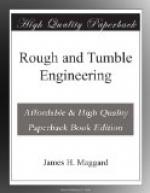Now the facts in this case were as follows: The old check valve in place of the one referred to had been one known as a stem valve, or floating valve. This stem by some means, had broken off but it did not prevent the valve from working. The stem, however, worked forward till it reached the hot water check, and lodged under the valve, which prevented this check from working and his pump refused to work, the engineer soon found where the stem had broken off, and instead of looking for the stem, sent to town for a new check, after putting this on the pump now refused to work for two reasons. One was, he had not removed the broken stem from the hot water check, and another was, that the new check was in wrong end to. After wasting another hour or two he finally found and-removed the stem from the hot water check, but his pump still refused to work. And then as the boys say, “he laid down,” and when I called his attention to the new valve being in wrong, he was so completely rattled that he made use of the above expression.
There are other causes that would prevent the pump working besides lack of packing and obstructions under the valves. The valve may stick. When it is raised to allow the water to flow through, it may stick in the valve chamber and refuse to settle back in the seat. This may be caused by a little rough place in the chamber, or a little projection on the valve, and can generally be remedied by tapping the under side of check with a wrench or hammer. Do not strike it so hard as to bruise the check, but simply tap it. If this don’t remedy the trouble, take the valve out, bore a hole in a board about I/2 inch deep and large enough to permit the valve to be turned. Drop a little emery dust in this hole. If you haven’t any emery dust, scrape some grit from a common whetstone. If you have no whetstone, put some fine sand or gritty soil in the hole, put the valve on top of it, put your brace on the valve and turn it vigorously for a few minutes, and you will remove all roughness.
Constant use may sometimes make a burr on the valve which will cause it to stick. Put it through the above course and it will be as good as new. If this little process was generally known, a great deal of trouble and annoyance could be avoided.
It will not be necessary to describe other styles of pumps. If you know how to run the cross head pump, you can run any of the others. Some engines have cross head pump only. Others have an independent pump. Others have an injector, or inspirator, and some have both cross head pump and injector. I think a farm engine should be supplied with both.




